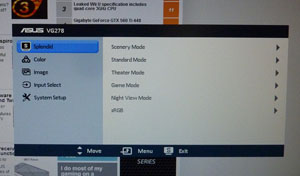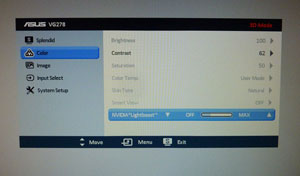The ASUS formula
How much?
ASUS treads a familiar path with the VG278H 3D monitor. Building on what it has learnt from previous NVIDIA-focussed 3D efforts, the 27in, 1,920x1,080-resolution screen packs in the necessary 120Hz refresh rate and, keeping everything simple, includes a pair of the new-fangled glasses that along with the screen satisfy the requirements for 3D Vision 2. Specifications are also fairly standard, coming in with 300cd/m² brightness and 2ms response timeThe kicker is the price, arriving at retail for some £550 for the all-in-one bundle. The new active-shutter glasses and receiver sells for £120 or so, meaning the vast bulk of the price rests with the monitor. In a time when a non-3D monitor of the same proportions is available for sub-£200, one is literally paying up to double for a screen imbued with three-dimensional trickery.
Panel-wise, ASUS runs with a tried-and-trusted twisted-nematic (TN) variant here. Primarily used for its fast response time and consequently quick grey-to-grey (G2G) transitions, it's a good choice for a 120Hz monitor. On the downside, TN screens tend to output colour using six bits per channel, thus natively producing just 262K gradations compared with 16.7M for the more-common 8-bit-per-channel panels.
The VG278H gets around this lack of colour fidelity by using a dithering technique called frame-rate control, where the panel runs through different shades with each new refresh to simulate intermediate colours that it can't produce natively.
An LED-backlit TN panel and £500-plus price may put monitor aficionados off at the first step, who tend to prefer the lushness and colour vibrancy of IPS panels, but we need to know more before passing judgement.
Looks
The well-built 27in panel looks a little different from its also-3D siblings. Rather than keep a standard-sized bezel all the way around - the VG278H's measures 20mm on the sides and bottom - there's a portion jutting out of the top that is home to an integrated 3D Vision emitter.
Knowing that NVIDIA's technology works best by having the emitter and glasses in fairly close proximity to each other, ASUS simply integrates the former into the chassis. What's clever here is that the emitter can be tilted a few degrees for optimum connectivity, and it works well when factoring in that the screen itself can be tilted forwards and backwards while also being height-adjustable by 10cm or so.
A couple of speakers pump out up to six watts RMS between them and the sound quality is reasonable, if not startling. We'd advise readers to invest in better-quality external speakers or headphones; the VG278H's audio is more perfunctory than room-filling.
Control buttons are located on the bottom right-hand side. Six buttons provide fairly simple access to the on-screen menu but there's no obvious way of determining if the monitor is actually switched on - there is a small blue LED that's hidden when peering at the monitor from the regular front view. Also, it takes a considerable while from an initial power-button depress to screen usage; we measured the total time to be 9.5s. This isn't a biggie when switching the PC on from a cold boot, obviously, yet feels like an age if pulling the system out of standby, with the user waiting for the screen to become active.
OSD and LightBoost
The on-screen display is fairly easy to navigate and provides a slew of image-quality settings that, once set, aren't likely to be changed again. The monitor seems overly bright and rich in contrast when first powered-up, indicating that NVIDIA's LightBoost technology is at play, but this is not the case.
LightBoost is only active when the screen is in 3D mode, as shown in the picture on the right. The purpose is to temporarily boost the brightness when the user is wearing the supplied glasses and viewing 3D content. Forcing LightBoost in a standard 2D environment causes the screen to look washed out. LightBoost levels can be manually adjusted in steps, too.
But it's a little more complex than that. The VG278H's regular brightness and contrast settings dictate just how well LightBoost works. This is because NVIDIA's technology simply adds to the ordinary brightness/contrast, whatever the base settings may be. Thinks of LightBoost as adding, say, an extra '30' on to the brightness, meaning that a monitor-set figure of '70' looks like '100.' It's just more light, which is precisely the aim here, and it works best if the standard brightness is already near the maximum 100.
NVIDIA's PR bumf quotes LightBoost as offering 2x the light of previous monitors. This claim is substantiated by the fact that running with LightBoost on can ramp the maximum cd/m² by up to 100 per cent from base settings. Certainly, the image is much, much brighter with LightBoost operating at full chat.
Inputs

HDMI, dual-link DVI and good, ol' VGA make up the VG278H's video inputs. Component gets the boot, underscoring a sign of the times, and, as a gesture to the built-in speakers, there are analogue inputs on the right-hand side. The monitor also uses a built-in power supply that's connected to a three-pin mains lead.
Driving a full-HD resolution with 120Hz - the basic tenets of 3D gaming - requires more bandwidth than the HDMI v1.4 port can provide. Putting it another way, 3D gaming can only be done if the PC is attached via the DVI port. Really, ASUS should update the HDMI specification to accept 3D Vision, especially as the monitor ships with speakers.













